Dividing Fractions and Mixed Numbers
Learning Objective(s)
· Find the reciprocal of a number.
· Divide two fractions.
· Divide two mixed numbers.
· Divide fractions, mixed numbers, and whole numbers.
· Solve application problems that require division of fractions or mixed numbers.
Introduction
There are times when you need to use division to solve a problem. For example, if painting one coat of paint on the walls of a room requires 3 quarts of paint and there are 6 quarts of paint, how many coats of paint can you paint on the walls? You divide 6 by 3 for an answer of 2 coats. There will also be times when you need to divide by a fraction. Suppose painting a closet with one coat only required ![]() quart of paint. How many coats could be painted with the 6 quarts of paint? To find the answer, you need to divide 6 by the fraction,
quart of paint. How many coats could be painted with the 6 quarts of paint? To find the answer, you need to divide 6 by the fraction, ![]() .
.
If the product of two numbers is 1, the two numbers are reciprocals of each other. Here are some examples:
| Original number | Reciprocal | Product |
|
|
|
|
|
|
|
|
|
|
|
|
|
|
|
|
In each case, the original number, when multiplied by its reciprocal, equals 1.
To create two numbers that multiply together to give an answer of one, the numerator of one is the denominator of the other. You sometimes say one number is the “flip” of the other number: flip ![]() to get the reciprocal
to get the reciprocal ![]() . In order to find the reciprocal of a mixed number, write it first as an improper fraction so that it can be “flipped.”
. In order to find the reciprocal of a mixed number, write it first as an improper fraction so that it can be “flipped.”
| Example | ||
| Problem | Find the reciprocal of | |
|
|
| Rewrite 4 • 5 + 1 = 21. |
|
Answer |
| Find the reciprocal by interchanging (“flipping”) the numerator and denominator. |
| What is the reciprocal of A)
B)
C)
D)
|
When you divide by a whole number, you multiply by the reciprocal of the divisor. In the painting example where you need 3 quarts of paint for a coat and have 6 quarts of paint, you can find the total number of coats that can be painted by dividing 6 by 3, 6 ÷3 = 2. You can also multiply 6 by the reciprocal of 3, which is ![]() , so the multiplication problem becomes
, so the multiplication problem becomes ![]() .
.
The same idea will work when the divisor is a fraction. If you have ![]() of a candy bar and need to divide it among 5 people, each person gets
of a candy bar and need to divide it among 5 people, each person gets ![]() of the available candy:
of the available candy: ![]() of
of ![]() is
is ![]() , so each person gets
, so each person gets ![]() of a whole candy bar.
of a whole candy bar.
If you have a recipe that needs to be divided in half, you can divide each ingredient by 2, or you can multiply each ingredient by ![]() to find the new amount.
to find the new amount.
Similarly, with a mixed number, you can either divide by the whole number or you can multiply by the reciprocal. Suppose you have ![]() pizzas that you want to divide evenly among 6 people.
pizzas that you want to divide evenly among 6 people.
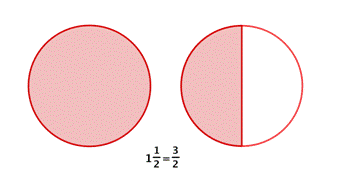
Dividing by 6 is the same as multiplying by the reciprocal of 6, which is ![]() . Cut the available pizza into six equal-sized pieces.
. Cut the available pizza into six equal-sized pieces.
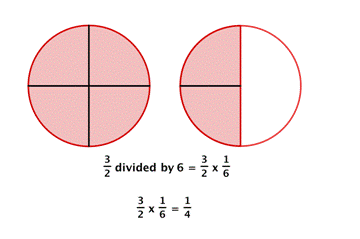
Each person gets one piece, so each person gets ![]() of a pizza.
of a pizza.
Dividing a fraction by a whole number is the same as multiplying by the reciprocal, so you can always use multiplication of fractions to solve such division problems.
| Example | ||
| Problem | Find | |
|
|
| Rewrite |
|
|
| Dividing by 4 or |
|
|
| Multiply numerators and multiply denominators. |
|
|
| Simplify to lowest terms by dividing numerator and denominator by the common factor 4. |
| Answer |
|
|
| Find
A)
B)
C)
D).
|
Sometimes you need to solve a problem that requires dividing by a fraction. Suppose you have a pizza that is already cut into 4 slices. How many ![]() slices are there?
slices are there?
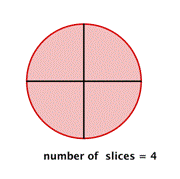
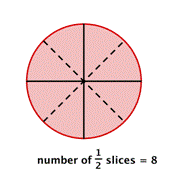
There are 8 slices. You can see that dividing 4 by ![]() gives the same result as multiplying 4 by 2. What would happen if you needed to divide each slice into thirds?
gives the same result as multiplying 4 by 2. What would happen if you needed to divide each slice into thirds?
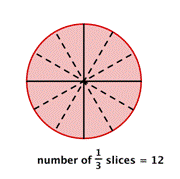
You would have 12 slices, which is the same as multiplying 4 by 3.
| Dividing with Fractions
1. Find the reciprocal of the number that follows the division symbol. 2. Multiply the first number (the one before the division symbol) by the reciprocal of the second number (the one after the division symbol).
Examples:
|
Any easy way to remember how to divide fractions is the phrase “keep, change, flip”. This means to KEEP the first number, CHANGE the division sign to multiplication, and then FLIP (use the reciprocal) of the second number.
| Example | ||
| Problem |
| Divide. |
|
|
| Multiply by the reciprocal: Keep |
|
|
| Multiply numerators and multiply denominators. |
|
|
| Simplify. |
|
Answer |
|
|
| Example | ||
| Problem |
| Divide. |
|
|
| Multiply by the reciprocal: Keep |
|
|
| Multiply numerators and multiply denominators. |
|
Answer |
|
|
When solving a division problem by multiplying by the reciprocal, remember to write all whole numbers and mixed numbers as improper fractions. The final answer should be simplified and written as a mixed number.
| Example | ||
| Problem |
| Divide. |
|
|
| Write |
|
|
| Multiply by the reciprocal: Keep |
|
|
| Multiply numerators and multiply denominators. |
|
|
| Simplify. |
|
Answer |
|
|
| Example | ||
| Problem |
| Divide. Simplify the answer and write as a mixed number.
|
|
|
| Write |
|
|
| Multiply by the reciprocal of
|
|
|
| Multiply numerators, multiply denominators. |
|
|
| Regroup. |
|
|
| Simplify: |
|
|
| Multiply.
|
|
|
| Rewrite as a mixed number. |
Answer |
|
|
| Find
A)
B)
C)
D) 8
|
Using multiplication by the reciprocal instead of division can be very useful to solve problems that require division and fractions.
| Example | ||
| Problem | A cook has | |
|
|
| You need to find how many quarter pounds there are in
|
|
|
| Write |
|
|
| Multiply by the reciprocal. |
|
|
| Multiply numerators and multiply denominators.
|
|
|
| Regroup and simplify |
| Answer | 75 burgers |
|
| Example | ||
| Problem | A child needs to take | |
|
|
| You need to make 4 equal doses, so you can use division. |
|
|
| Write |
|
|
|
Multiply by the reciprocal. |
|
|
| Multiply numerators and multiply denominators. Simplify, if possible. |
| Answer |
|
|
|
How many
A)
B)
C) 30
D)
|
Summary
Division is the same as multiplying by the reciprocal. When working with fractions, this is the easiest way to divide. Whether you divide by a number or multiply by the reciprocal of the number, the result will be the same. You can use these techniques to help you solve problems that involve division, fractions, and/or mixed numbers.
